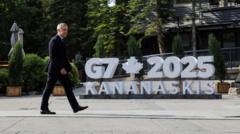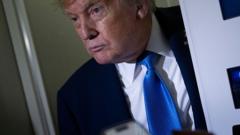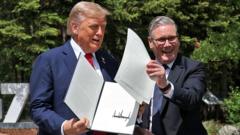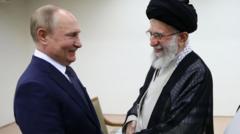As the G7 summit concluded in Kananaskis, Alberta, under the leadership of first-time host Mark Carney, a sudden departure from US President Donald Trump overshadowed the meticulously crafted agenda. Here are five key takeaways from this pivotal gathering that highlighted the precarious balance between international cooperation and individual national interests.
G7 Summit Unravels: Trade Talks and Middle East Tensions Dominate as Trump Exits Early

G7 Summit Unravels: Trade Talks and Middle East Tensions Dominate as Trump Exits Early
Amidst escalating Middle East conflict and unexpected departures, the G7 summit reveals pressing issues and unanticipated compromises.
Trump's Unforeseen Exit
The summit bore witness to an extraordinary moment as President Trump left abruptly, prioritizing developments from the Israel-Iran conflict over scheduled discussions. The remaining G7 leaders - Italy, France, Germany, the UK, Canada, and Japan - responded with tact, emphasizing their understanding of the US leader's decision. French President Emmanuel Macron dismissed comments on Trump's exit suggesting a de facto G6, asserting the group's unity despite the US president's withdrawal. Trump's absence meant the cancellation of significant bilateral dialogues with other leaders but provided an opportunity for less tension among those remaining.
Middle East Conflict Overshadows Agenda
The war between Israel and Iran quickly took precedence over the G7 agenda, with live updates redirecting international focus. G7 leaders called for a de-escalation of hostilities while avoiding a definitive ceasefire announcement, with Trump publicly disagreeing with Macron over the US's stance on ceasefire discussions. Despite the tensions, the collective G7 statement showcased an effort toward unified diplomatic support for peace in the Middle East.
Ukraine and India: A Test of Consensus
Despite hopes for a strong collaborative stance on Ukraine, reports indicated that the summit fell short of a collective statement from G7 leaders. Canadian Prime Minister Carney faced challenges reconciling differing national sentiments, particularly concerning the situation with India following diplomatic turmoil. Talks during the summit emphasized security and crime meant to address bilateral relations, yet led to further domestic scrutiny for Carney.
Trade Talks Remain Central Focus
One of the summit's highlights was the dialogue between Carney and Trump regarding trade agreements amidst ongoing tariff disputes. Hurdles remain, with perspectives differing significantly, yet both sides agreed to pursue negotiations aggressively in the forthcoming month. Carney's focus on leveraging Canada's trade discussions highlighted aspirations to strengthen economic independence from the US while aiming for broader agreements with European nations.
Ultimately, the G7 summit reflected a complex interplay of geopolitical tensions and diplomatic negotiations, with leaders striving to adapt to rapidly changing circumstances while pushing for co-operation on urgent global issues.
The summit bore witness to an extraordinary moment as President Trump left abruptly, prioritizing developments from the Israel-Iran conflict over scheduled discussions. The remaining G7 leaders - Italy, France, Germany, the UK, Canada, and Japan - responded with tact, emphasizing their understanding of the US leader's decision. French President Emmanuel Macron dismissed comments on Trump's exit suggesting a de facto G6, asserting the group's unity despite the US president's withdrawal. Trump's absence meant the cancellation of significant bilateral dialogues with other leaders but provided an opportunity for less tension among those remaining.
Middle East Conflict Overshadows Agenda
The war between Israel and Iran quickly took precedence over the G7 agenda, with live updates redirecting international focus. G7 leaders called for a de-escalation of hostilities while avoiding a definitive ceasefire announcement, with Trump publicly disagreeing with Macron over the US's stance on ceasefire discussions. Despite the tensions, the collective G7 statement showcased an effort toward unified diplomatic support for peace in the Middle East.
Ukraine and India: A Test of Consensus
Despite hopes for a strong collaborative stance on Ukraine, reports indicated that the summit fell short of a collective statement from G7 leaders. Canadian Prime Minister Carney faced challenges reconciling differing national sentiments, particularly concerning the situation with India following diplomatic turmoil. Talks during the summit emphasized security and crime meant to address bilateral relations, yet led to further domestic scrutiny for Carney.
Trade Talks Remain Central Focus
One of the summit's highlights was the dialogue between Carney and Trump regarding trade agreements amidst ongoing tariff disputes. Hurdles remain, with perspectives differing significantly, yet both sides agreed to pursue negotiations aggressively in the forthcoming month. Carney's focus on leveraging Canada's trade discussions highlighted aspirations to strengthen economic independence from the US while aiming for broader agreements with European nations.
Ultimately, the G7 summit reflected a complex interplay of geopolitical tensions and diplomatic negotiations, with leaders striving to adapt to rapidly changing circumstances while pushing for co-operation on urgent global issues.






















